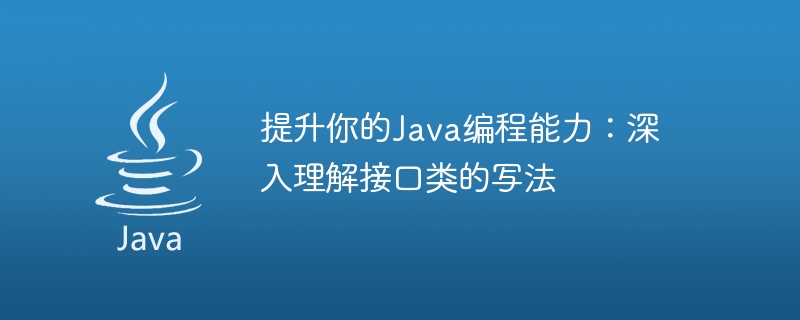

Improve your Java programming ability: In-depth understanding of how to write interface classes
Introduction:
In Java programming, interface is a very important concept. It can help us achieve program abstraction and modularization, making the code more flexible and extensible. In this article, we will delve into how to write interface classes and give specific code examples to help readers better understand and apply interfaces.
1. Definition and characteristics of interface
In Java, interface is an abstract type. It is similar to a contract or contract, which defines the specification of a set of methods without providing a specific implementation. Other classes can implement the interface and provide specific method implementations. The interface is defined using the interface keyword.
The main features of the interface are as follows:
2. Example of how to write an interface
In order to better understand how to write an interface, let’s look at a specific example-the interface definition of animals and aircraft.
// 定义动物接口
interface Animal {
void eat();
void sleep();
}
// 定义飞行器接口
interface Flying {
void takeOff();
void fly();
void land();
}
// 实现动物接口的类
class Dog implements Animal {
public void eat() {
System.out.println("狗吃东西");
}
public void sleep() {
System.out.println("狗睡觉");
}
}
// 实现动物接口和飞行器接口的类
class Bird implements Animal, Flying {
public void eat() {
System.out.println("鸟吃东西");
}
public void sleep() {
System.out.println("鸟睡觉");
}
public void takeOff() {
System.out.println("鸟起飞");
}
public void fly() {
System.out.println("鸟飞行");
}
public void land() {
System.out.println("鸟降落");
}
}In the above example, we first define an animal interface (Animal), which contains two abstract methods eat() and sleep(). Then, we defined an aircraft interface (Flying), which contains three abstract methods: takeOff(), fly(), and land().
Next, we implemented the animal interface (Dog class), animal interface and aircraft interface (Bird class) respectively. In the implementation class, we have to provide concrete implementations of all the methods defined in the interface.
3. Interface application examples
In order to better use the interface, we can consider the following case - a zoo management system.
class ZooKeeper {
void feedAnimal(Animal animal) {
animal.eat();
}
void putAnimalToSleep(Animal animal) {
animal.sleep();
}
}
public class Main {
public static void main(String[] args) {
ZooKeeper zooKeeper = new ZooKeeper();
Animal dog = new Dog();
Animal bird = new Bird();
zooKeeper.feedAnimal(dog);
zooKeeper.putAnimalToSleep(dog);
zooKeeper.feedAnimal(bird);
zooKeeper.putAnimalToSleep(bird);
}
}In the above example, we defined a ZooKeeper class, which has two methods: feedAnimal() and putAnimalToSleep(). These two methods accept an Animal type parameter and can handle various animals.
In the main function, we create a ZooKeeper object and instantiate a Dog object and a Bird object respectively. Then, we call ZooKeeper's methods to feed and arrange the animals to sleep.
Through this case, we can see the flexibility and scalability of interfaces in practical applications. We only need to implement the corresponding interfaces, and we can easily provide corresponding services to different types of animals.
Conclusion:
By in-depth understanding of how to write interface classes and practicing in practical applications, we can improve our abilities in Java programming. The abstract characteristics and modular design of interfaces can help us write more flexible, scalable and maintainable code. I hope this article can be helpful to readers and make them more comfortable in using the interface.
The above is the detailed content of Expand your Java programming skills: In-depth exploration of how to write interface classes. For more information, please follow other related articles on the PHP Chinese website!




